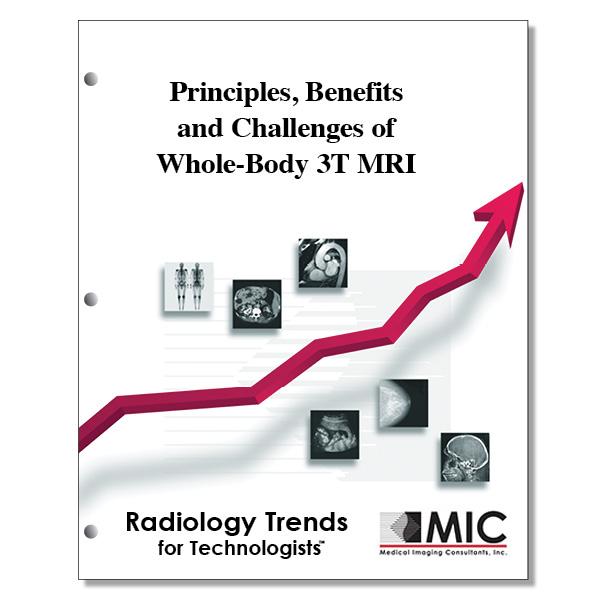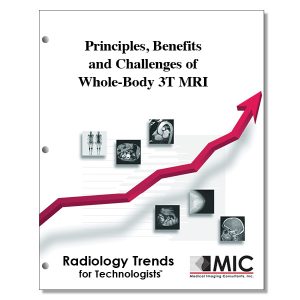

Principles, Benefits and Challenges of Whole-Body 3T MRI
In the first of a two-part series about high-field-strength MR imaging, the physical effects at 3.0T are presented, along with benefits and challenges that are encountered.
Course ID: Q00462 Category: Radiology Trends for Technologists Modality: MRI4.0 |
Satisfaction Guarantee |
$39.00
- Targeted CE
- Outline
- Objectives
Targeted CE per ARRT’s Discipline, Category, and Subcategory classification for enrollments starting after January 28, 2025:
Magnetic Resonance Imaging: 4.00
Safety: 0.25
MRI Screening and Safety: 0.25
Image Production: 1.75
Physical Principles of Image Formation: 0.75
Sequence Parameters and Options: 0.75
Data Acquisition, Processing, and Storage: 0.25
Procedures: 2.00
Neurological: 2.00
Outline
- Introduction
- Physical Effects of Higher Magnetic Field Strengths
- Signal-to-Noise Ratio
- Larmor Frequency and Chemical Shift
- Relaxation Times
- Contrast-enhanced MR Imaging
- Susceptibility
- RF Deposition and Specific Absorption Rate
- Dielectric Effects
- How to Deal with High-Field-Strength-Related Difficulties
- Deal with Increased Chemical Shift
- Compensate for Altered Relaxation Times
- Avoid Susceptibility Effects
- Cope with Increased RF Deposition
- Correct Dielectric Effects
- Patient Safety Issues
- Clinical Applications
- Structural Brain Imaging
- DWI and Diffusion-Tensor Imaging
- Susceptibility-based and Perfusion Imaging
- MR Angiography
- Conclusion
Objectives
Upon completion of this course, students will:
- identify terminology used to measure magnetic field strength at system isocenter
- learn the basic methods used to compensate for the artifacts and physical effects of higher field strength imaging
- identify the measure of quality in MR imaging, as SNR relates to magnetic field strength
- define and describe signal to noise ratio
- define spatial resolution, the measure of detail in MR imaging
- establish the advantage of shorter in-phase times realized with 3.0T systems as compared to 1.5T
- define the cause of safety concerns of higher field MR systems
- identify factors that increase RF absorption
- establish FDA limits for whole body SAR
- define and establish clinical limitations to B1 inhomogeneity
- define chemical shift as it relates to magnetic field strength
- identify the type and location of chemical shift artifacts
- identify advantages of chemical shift at higher field strengths
- learn the impact of gray matter-to-white matter contrast at 3T
- establish 3T’s effect on tissues’ T1 and T2 relaxation times, compared to 1.5T
- identify the function of gadolinium as an intravenous contrast agent used in MRI imaging
- define magnetic susceptibility
- identify the sequences most prone to the effects of magnetic susceptibility
- learn the fundamental sequences that exploit the advantages of increased susceptibility effects at 3.0T
- identify threshold limitations for RF deposition limiting heating of human tissue
- establish the factor adjustments that lead to increases in RF deposition
- compare low SAR with fast MRI pulse sequences and the clinical impact on patient care
- define B1 inhomogeneity and describe its effect on an image
- identify dielectric effects in MRI imaging
- establish the clinical application of the predominant phase when dielectric effects occur
- identify the most common corrective measure in compensating for chemical shift artifacts
- establish the advantages of employing a wide receiver bandwidth
- identify the common corrective measures for altered relaxation times at 3.0T
- establish the impact of receiver bandwidth changes on the SNR
- establish the impact of TR in T1 weighted images
- identify susceptibility artifacts
- identify corrective measures in avoiding susceptibility effects
- identify the two main methods of coping with RF deposition at high field strengths
- identify the application of parallel imaging in dealing with RF deposition
- define the value and impact of flip angle modulation techniques when managing RF deposition in patients
- identify the anatomic region least prone to artifacts, SAR limitations, and RF penetration uniformity
- identify 3T’s impact on cerebral lesions crossing the blood brain barrier with contrast enhanced T1 weighted images
- identify the main corrective measure for reduction of susceptibility effects in diffusion weighted imaging
- define perfusion and establish its clinical value
- establish the clinical advantages of time resolved MR angiography
